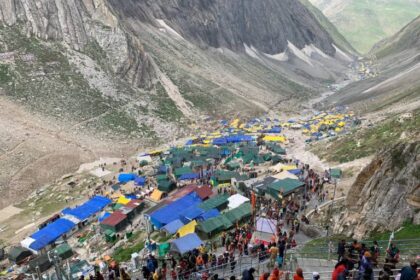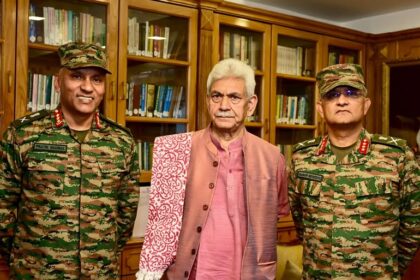J&K’s New Business Rules: More Powers to CM & Ministers, But LG Retains Supreme Authority
While the Transaction of Business Rules-2025 grant Chief Minister Omar Abdullah and his Council of Ministers expanded administrative powers, the Lieutenant Governor Manoj Sinha remains the final authority on crucial matters, ensuring New Delhi’s control over Jammu and Kashmir’s governance.
||Black and White Digital News ||
||Parvinder Singh March 17,2025 ||
A Fine-Tuned Power Equation: What’s Changed and What Hasn’t?
The Jammu and Kashmir administration has introduced the Transaction of Business Rules-2025, which aim to redefine governance by providing a more structured role for the elected government while ensuring the Lieutenant Governor (LG) retains overriding authority in key administrative matters.
Drafted by legal experts and vetted by a ministerial committee, these rules are not a radical departure from the 2019 framework but instead focus on enhancing consultative decision-making between the elected government and the LG. While the Chief Minister and his Cabinet have gained more operational powers, especially in financial decision-making and bureaucratic appointments, the LG still wields the ultimate authority, particularly in law and order, police, finance, and major policy decisions.
Key Aspects of the Transaction of Business Rules-2025
1. Transfers and Postings: Ministers Can Recommend, But LG Has Final Say
One of the most contentious issues in governance has been the transfer and posting of All India Service (AIS) officers, including police and administrative officials.
• Under the 2019 rules, the LG had absolute control over postings in key departments such as Home, Police, and the Anti-Corruption Bureau (ACB), leaving the Council of Ministers with no authority over these crucial areas.
Under the 2025 rules, the Chief Minister and Ministers can now propose transfers, but these will not be binding on the LG, who retains final authority over appointments.
For Jammu and Kashmir Administrative Service (JKAS) officers, however, the Council of Ministers now has full control over their transfers, which is a shift toward localized decision-making.
This change creates a perception of empowerment for the elected government, but in reality, the final decision-making power remains firmly with the LG, ensuring that bureaucratic control remains centralized.
2. Financial Autonomy: More Power to the CM, But Within Limits
Financial governance has historically been a tightly controlled domain under the LG’s office, with most budgetary approvals requiring direct LG intervention.
Under the 2019 rules, no financial orders could be issued without clearance from the Finance Department and the LG’s office.
The 2025 rules introduce flexibility by allowing the Chief Minister and Ministers to approve financial matters within pre-defined limits without seeking prior approval from the LG.
Any major budgetary allocation, financial restructuring, or additional expenditures beyond specified limits will still require LG’s approval, ensuring that significant fiscal decisions remain under LG’s control.
This adjustment grants the Chief Minister (who also holds the Finance portfolio) greater authority in routine financial matters, but large-scale economic decisions remain under the LG’s purview.
3. Conflict Resolution: LG Can No Longer Escalate Disputes to Centre
A major governance challenge under the 2019 rules was the lack of conflict resolution mechanisms between the LG and the Council of Ministers.
Previously, in the event of a disagreement between the elected government and the LG, the LG could override the CM and escalate the matter directly to the Central Government, effectively neutralizing the elected government’s role.
Under the 2025 rules, if the Council of Ministers reaffirms a decision despite LG’s objections, the matter will be resolved internally, without escalation to New Delhi.
This creates a more structured mechanism for handling disputes, but since the LG still holds discretionary power, the practical impact of this change remains to be seen.
While removing direct central intervention may appear to be a move toward autonomy, the fact that the LG retains overriding authority means that the final power balance remains unchanged.
4. Role of the Chief Minister: From Advisory to Decision-Making, But Not Absolute
Under the 2019 rules, the Chief Minister’s role was largely advisory, with all significant governance matters requiring LG’s approval.
The 2025 rules redefine the CM’s role, granting him greater authority over financial, administrative, and policy decisions.
The Council of Ministers is now explicitly responsible for executive orders, including:
Policy decisions
Budget approvals
Appointments and transfers
Administrative directives
Ministers can now handle cases independently, but LG’s discretionary power remains intact, allowing intervention when necessary.
Despite these enhancements to the CM’s authority, the LG’s final approval is still needed for major governance matters, ensuring that the Union Government’s oversight remains firmly in place.
5. Chief Secretary’s Role: Reduced Influence, More Power to Ministers
The 2019 rules positioned the Chief Secretary as a key figure in governance, acting as the primary link between the LG and various departments.
Every government order required the Chief Secretary’s involvement, ensuring tight bureaucratic control over decision-making.
Under the 2025 rules, the Chief Secretary’s role has been reduced, with more powers delegated to the Council of Ministers.
This means that ministries now have more autonomy in day-to-day governance, but since the LG retains final authority, bureaucratic oversight remains strong.
The Bigger Picture: A Shift Toward Local Governance, But With Strings Attached
The Transaction of Business Rules-2025 signal a modest shift toward empowering the elected government, but they do not fundamentally alter the centralized nature of governance in Jammu and Kashmir.
The Lieutenant Governor continues to hold absolute authority over law and order, police, finance, and policy matters, ensuring that the Union Government maintains a tight grip over J&K’s administration.
The removal of the Central Government’s role in resolving disputes between the LG and the Council of Ministers is a procedural change rather than a power shift.
The Chief Minister and his ministers now have more operational control, but this is subject to strict oversight from the LG’s office.
While the 2025 rules create a more structured governance framework, they do not restore the full autonomy that Jammu and Kashmir once had before the revocation of Article 370.
Conclusion: A Step Forward, But Not a Game-Changer
The Transaction of Business Rules-2025 are being viewed as a partial restoration of democratic governance, but they stop short of granting full autonomy to the Chief Minister and his Council of Ministers.
The LG still holds final authority over critical governance areas, ensuring that New Delhi’s influence remains intact.
More authority over financial and administrative matters gives the elected government greater operational flexibility but within well-defined limits.
The removal of direct central intervention in disputes is a symbolic move, but since the LG retains discretionary power, real decision-making power remains concentrated in Raj Bhawan.
Ultimately, while the 2025 rules introduce a more structured and consultative governance model, they reinforce the status quo—where the elected government operates under the overarching authority of the Lieutenant Governor and, by extension, the Central Government.
Office of LG, J&K
Omar Abdullah
Deputy CM Surinder choudhary
Satish Sharma
Sat Sharma CA
Sunil Sharma
Jammu and Kashmir
Ankur Sharma
Tarun Chugh
#chiefsecretaryjammuandkashmir









